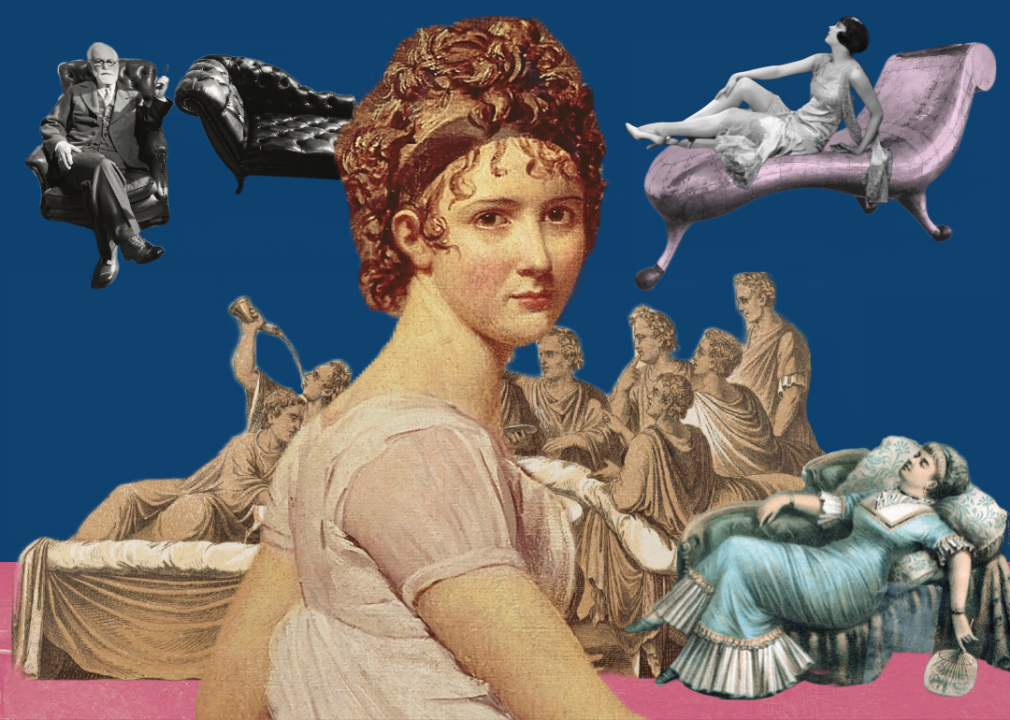From the Roman Empire to your therapist's office: The history of the chaise lounge

Photo Illustration by Elizabeth Ciano // Stacker // Getty Images
From the Roman Empire to your therapist’s office: The history of the chaise lounge
Collage with painting of Madame Recaimer and chaise lounge vignettes from history.
Furniture may change in style or function over the years, even taking on various names across different eras or in different parts of the world, yet certain pieces have a way of standing the test of time. The chaise lounge embodies this longevity, originating in ancient times but still appearing in contemporary homes today. Living Spaces researched the lengthy life span of the chaise lounge, gathering information from various sources to compile a comprehensive history of this enduring piece.
Ancient, luxurious origins
Variations on what is now known as the chaise lounge date all the way back to ancient Egypt. Much has been learned about these daybed-style seats as modern archaeologists have uncovered artifacts depicting how they were used in ancient times. An early image is a 7th-century-B.C. bas-relief of an Assyrian king reclining on a sofa, his wife seated beside him, while feasting in celebration of a great victory. In his story for The Paris Review, Witold Rybczynski noted how surprisingly tall these reclining couches were—almost 5 feet off the ground.
In ancient Greece, chaise lounges were called “klinai” (“kline” in singular form), meaning “banquet couches” or “beds.” Typically made of wood with elaborate decorations, they were multifunctional status symbols used for eating, resting, and even laying out the dead. Known by the same name in ancient Turkey—or Anatolia, as the area was called then—klinai have been discovered in tombs, implying an extravagant send-off into the afterlife. Like their Greek counterparts, these Turkish pieces featured ornate decorations—inlaid ivory or amber, even gold or silver plating—to flaunt the owner’s wealth.
Fitting with the popular perception of ancient Romans as overindulgent, even hedonistic, chaise lounges during this period were used by prominent men to feast happily for hours—although women were not allowed the same luxury until much later in history. Leaders of the Roman Empire stretched out upon their stomachs to help decrease bloating and ease digestion during their massive meals. Some diners even became comfortable enough to take a brief nap in between courses.
A more modern comeback
The prevalence of these sumptuous sofas and daybeds waned during the Middle Ages before making a comeback in the 18th and 19th centuries. Unlike in ancient Rome, during this period the lounges were used primarily by women—first in their bedchambers for rest and relaxation, and then becoming more common in living areas as well.
French furniture designers resurrected the chaise lounge as a coveted status symbol by introducing three styles that would remain popular for centuries. The Duchesse brisée, meaning “broken Duchess,” was a multipiece set: a standard chair plus one or two additional footstools that formed a full-length chaise lounge when placed together.
In the early 1800s, a second style became all the rage when Paris socialite Juliette Récamier was painted lounging on a sofa with sleek curved ends. According to Amy Azzarito’s “Elements of a Home,” Jacques-Louis David’s portrait kickstarted the migration toward overfurnished European living rooms. Her portrait was so influential that the chaise took on her name, Récamier, and this iconic painting now hangs in the Louvre.
The third style is an asymmetrical piece with high arms on one end sloping down toward the foot of the bench. As the name méridienne implies—derived from the French word for midday—this lounge was a comfortable resting place while the sun was up.
Lounge vs. longue
As the popularity of these pieces spread outside of France beginning in the late 1700s, their names also evolved. The original French term was not actually chaise lounge but rather chaise longue, meaning “long chair.” Both names refer to the same object. During the Victorian era—which spanned from 1837 to 1901, during the reign of England’s Queen Victoria—these sofas were also commonly known as fainting couches.
Historical research shows that Victorian women often had difficulty breathing or became lightheaded thanks to their tightly-laced corsets. These couches served the necessary function of providing a place to rest and recover when so-called swooning women felt unwell. Some homes even dedicated an entire room—aptly called a fainting room—to housing these fainting couches.
A chair for revelations
One particular Victorian-era figure created an image of the chaise that still echoes through popular culture more than a century later. In the 1890s, the so-called father of psychoanalysis, Sigmund Freud, was given a chaise lounge by one of his patients, Madame Benvenisti. Commonly referred to as his couch, this long seat featuring an elevated headrest on one end was, by definition, a chaise lounge.
Although built with a simple wooden structure, Freud covered the seat in a decorative carpet and cushions to make it more inviting. The idea was to allow patients to lie down and relax during sessions, encouraging them to freely share their thoughts as he sat behind their heads, poised to analyze these revelations. Inspired by Freud’s approach, many modern therapists still include cozy chaise lounges and sofas in their offices.
Mid-century modernized
The 20th century saw chaises reinvented and marketed uniquely by contemporary American designers and stores. In the 1920s, retailers like Sears and Roebuck and Montgomery Ward further popularized the term “chaise lounge” via their catalogs.
Inspired by writer-director Billy Wilder—known for his Hollywood classics “Sunset Boulevard” and “Some Like It Hot”—the popular mid-century furniture company Eames created an iconic modern chaise in 1968. This narrow, armless piece—only 17.5 inches wide—featured black leather cushions and a unique curved shape that cupped the body while loungers lay on their backs.
Perhaps the most expensive—and least functional—chaise lounge ever produced was the Lockheed Lounge, designed by Marc Newson in 1990. This highly stylized, three-footed piece was made of plastic reinforced with fiberglass and then covered in aluminum plates. Featured in Madonna’s “Rain” music video in 1993, the lounge later sold at auction in 2015 for an astonishing $3.7 million.
Chaise lounges have evolved tremendously over nearly five millennia, yet one thing remains the same: These comfortable chairs are used daily by people across the world. Contemporary lounges may not be as luxurious as their antique predecessors or have their own dedicated room as the fainting couch did, but they are still functional furniture staples in many homes. Whether incorporated into living sofas and sectionals or used poolside for sunbathing in between swimming laps, it is clear the chaise lounge is here to stay.
Story editing by Carren Jao. Copy editing by Paris Close.
![]()



